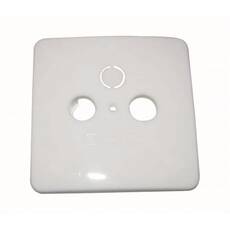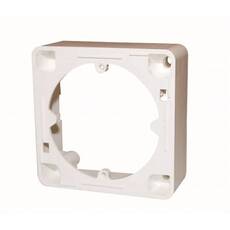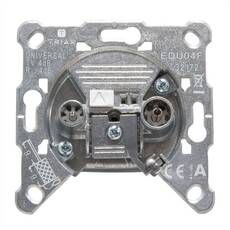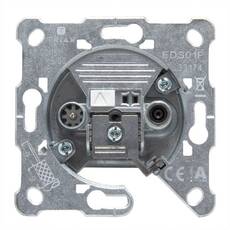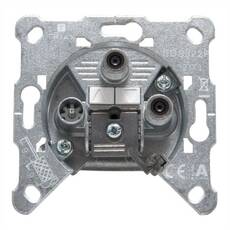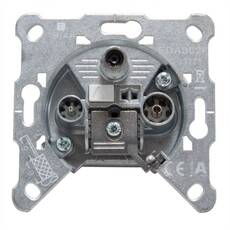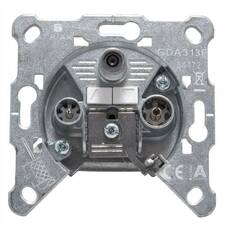TV Wall Socket
Without a television or radio, it's hard to imagine our homes. However, to receive and display TV and radio signals, your house or apartment must meet certain requirements. First and foremost, we need to provide professional reception technology. Read more...
• Antenna socket with 1 TV and 1 Radio output
• FM connector: IEC female
• TV connector: IEC male
• RF connector: IEC female
• Frequency range IN-OUT: 5-1000 MHz
• Frequency range FM: 87-108 MHz
• Frequency range TV: 5-68 / 118-1000 MHz
• Impedance: 75 Ω
• Suitable for multi-switch and individual satellite systems
• 3 connection options: SAT receiver via F connector, ground terminals via IEC connectors, FM radio via IEC socket
• Frequency range FM: 87-108 MHz
• Frequency range TV: 5-75/118-862 MHz
• Frequency range SAT: 950-2150 (2400) MHz
• TV-RF isolation: 20,0 dB
• Impedance: 75 Ω
• For Triax Outlets
• Colour: RAL 9010, pure white
• Surface mount frame for TRIAX sockets
• Colour: RAL 9010, pure white
• Type: transit
• Attenuation: 7 dB
• Marking: TV (7) + R (7)
• Insertion loss: 3 dB
• Connection type: IEC
• Dimensions: 26 × 60 × 60 mm
• Type: end connector
• End attenuation: 3 dB
• Marking: TV (2) + R (2) + SAT (3)
• Connector type: IEC + F (female)
• Dimensions: 26 × 60 × 60 mm
• 2-hole universal socket with pass-through frequency ranges
• N-OUT connector: spring clamp end
• TV connector: IEC male
• RF connector: IEC socket
• Frequency range TV: 5...2150 (2400) MHz
• RF frequency range: 5...2150 (2400) MHz
• Isolation TV-FM: 20,0 dB
• Impedance: 75 Ω
• Specially designed for SAT IF systems with optional DVB-T operation
• Impedance: 75 Ω
• TV connector: IEC male
• TV frequency range: 5...862 MHz
• SAT frequency range: 950...2400 MHz
• Output type: discontinued
• Isolation TV-SAT: 20,0 dB
• Impedance: 75 Ω
• FM connector: IEC socket
• TV connector: IEC male
• Output type: discontinued
• TV frequency range: 5...862 MHz
• Frequency range SAT: 950...2400 MHz
• Frequency range SAT 2: 5...2400 MHz
• Isolation TV-SAT: >20,0 dB
• Impedance: 75 Ω
• FM connector: IEC socket
• TV connector: IEC male
• Output type: terminated
• Frequency range FM: 5...118 MHz
• Frequency range TV: 5...862 MHz
• Frequency range SAT: 950...2150 (2400) MHz
• FM-SAT decoupling: 30,0 dB
• Isolation TV-SAT: >20,0 dB
• Isolation TV-FM: 20,0 dB
• Impedance: 75 Ω
• IN-OUT connector: spring clamp end
• FM connector: IEC socket
• TV connector: IEC male
• Frequency range IN-OUT: 5...2150 (2400) MHz
• Frequency range FM: 5...118 MHz
• Frequency range TV: 5...862 MHz
• Frequency range SAT: 950...2150 (2400) MHz
• Output type: loop
A wall socket connector is an electrical fitting that provides multiple connection options for receiving devices. The purpose of a socket is to provide radio and TV signals or frequencies that are transmitted to receivers using coaxial cables.
Structure of TV sockets
The antenna sockets are of standard construction and are fitted with standard connections. Previously there were two connections, one for cable TV or antenna and one for FM radio transmission. Nowadays, TV sockets are increasingly designed for cable TV. This means that in addition to the radio and TV connection, there is an additional cable TV connection. The reason for this development is that broadcasting services have changed. Satellite broadcasting is increasingly taking over. What exactly does this mean? In the past, radio and TV connections were usually made using power connectors suitable for IEC plugs, but nowadays we use F-connectors. This is an RF-type connector used in cable, satellite and terrestrial television with RG-6 type coaxial cable. It is a modern version of coaxial cables, which, unlike normal aerial cables, is fitted with an F-connector at both ends. There are also multimedia antenna connectors. They also have a different construction. A multimedia connector can be used to connect cable TV, a satellite dish and a terrestrial receiver, i.e. R/TV.
What types of TV sockets exist?
Wall sockets can be used separately or in combination with each other. However, variation is not possible with all types of sockets. Manufacturers distinguish between three main types: the simple one, which has a single socket, one that communicates, and one of the terminal type.
How to install a TV socket?
We start this process by preparing the aerial cable. Usually the wire is already plugged in and slightly protruding from the wall. The first step is to strip 1-1.5 cm off the end of the cable. To do this, use a sharp knife, if you do not have a suitable tool, compression or crimping pliers. Then carefully cut the outer part of the cable without damaging the shielding underneath. Then bend the shielding braid out over the cable so that the inner insulation is exposed. Then cut off the insulation 8-10 mm from the end of the cable and remove the affected piece to expose the inner conductor.
Make sure that the inner conductor remains intact. This is what professionals call blanching. In the next step, remove the cover of the wall socket and loosen the fixing screw to allow the prepared end of the cable to pass through. Then push in the end of the cable. The input and output of the antenna are usually marked with arrows, making it almost impossible to miss. The arrow pointing towards the box indicates the input, the arrow pointing away from the box indicates the output. After inserting the cable, retighten the clamping screw.
This takes a little bit of manual dexterity, but it's a task that anyone can do with ease. In addition, it is important to make sure that the inner wire and the shielding do not touch each other, otherwise there is a risk of short circuit. Finally, place the socket on the wall, screw the screw in tightly and replace the cover.
What to look out for when buying a TV socket outlet?
When choosing the right wall socket, the type and number of connections and the specific design are important considerations. Most antenna sockets are recessed or wall-mounted. If you want to install the socket under plaster, you will need recessed boxes. TV sockets are available in different sizes and have different numbers of cable inputs. But perhaps the most important thing is to determine exactly which sockets (TV, VHF, SAT, DATA) and how many you will need. For example, if you want to connect multiple TVs to the wall socket, choose a version with multiple TV inputs.
A well-placed and properly wired TV socket is not only aesthetically pleasing, but also contributes to uninterrupted entertainment because of the tidiness of cables and convenient access. Check out our range in the DND Telecom Center webshop!




